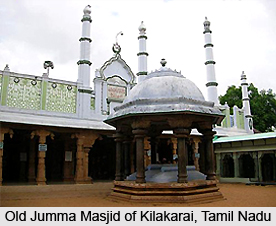 Old Jumma Masjid of Kilakarai is the most ancient mosque in the entire country and the fourth-oldest mosque of the world located in Kilakarai village in the southern Indian state of Tamil Nadu. The mosque is also popularly referred to as `Meen Kada Palli` or `Palaiya Jumma Palli`. The Jumma Masjid of Kilakarai represents the glory of Islamic heritage dating back to over 1000 years and it was constructed during 628 to 630 AD. However, the mosque was remobilized in 1036 and is believed to be amongst the finest instances of Islamic architecture in the southern portion of India. One obtains a fair knowledge of how creative the Islamic rulers of India were.
Old Jumma Masjid of Kilakarai is the most ancient mosque in the entire country and the fourth-oldest mosque of the world located in Kilakarai village in the southern Indian state of Tamil Nadu. The mosque is also popularly referred to as `Meen Kada Palli` or `Palaiya Jumma Palli`. The Jumma Masjid of Kilakarai represents the glory of Islamic heritage dating back to over 1000 years and it was constructed during 628 to 630 AD. However, the mosque was remobilized in 1036 and is believed to be amongst the finest instances of Islamic architecture in the southern portion of India. One obtains a fair knowledge of how creative the Islamic rulers of India were.
History of Old Jumma Masjid of Kilakarai
The Old Jumma Masjid of Kilakarai had been erected by Yemeni merchants and traders who had settled in the Pandya kingdom. The construction had been ordered by the Governor of Yemen, known as `Baadhan` or `Bazan ibn Sasan` during the age of Muhammad, after the citizens had embraced the religion of Islam during 625 to 628 AD. This was during the time of the son of Khosrau II, the King of Persia and also Kavadh II. Following the Saheed War, the mosque was reconstructed in 11th century. Some of the reputed Islamic scholars who paid a visit to the Old Jumma Masjid included Nagoor Abdul Cadir, Tamim Ibn Zayd-al-Ansari, Ibn Batutah, Sultan of Ottoman Murad, Ervadi Ibrahim Sahib, Bazan Ibn Sasan and many others.
Architecture of Old Jumma Masjid of Kilakarai
The Old Jumma Masjid of Kilakarai is of a similar appearance to that of a Hindu temple and is devoid of any idol carvings on the walls or pillars of outer and inner walls of the mosque. Devotees will observe a carving on its wall which signifies the direction of prayer and this is the only singular evidence that the pilgrimage spot is a mosque. The Arabs and their next generations had been entrusted the responsibility of managing this ancient mosque. Elaborate carvings are present on the surfaces of the walls of the mosque and lofty beams are also present in the `pallavasal` of the mosque. The mosque bears a Dravidian architectural look, which implies a distinctive architectural pattern.





















